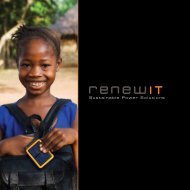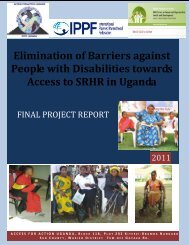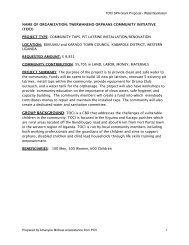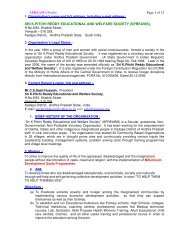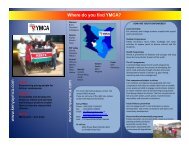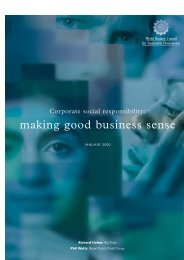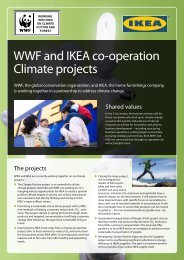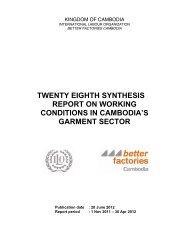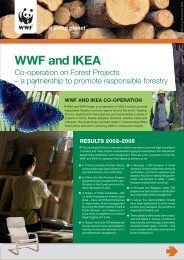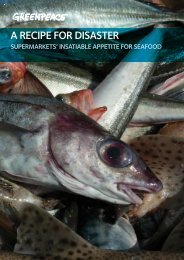Project Proposal on Organic Farming.pdf - Global Hand
Project Proposal on Organic Farming.pdf - Global Hand
Project Proposal on Organic Farming.pdf - Global Hand
Create successful ePaper yourself
Turn your PDF publications into a flip-book with our unique Google optimized e-Paper software.
USING ORGANIC FARMING TO IMPROVE FOOD,NUTRITION AND INCOME SECURITY FORRURAL POOR FARMERSPREPARED BY:COMMUNITY SUSTAINABLE DEVELOPMENT EMPOWERMENTPROGRAMME(COSDEP)Training farmers to secure their futureCommunity Sustainable Development Empowerment Programme (COSDEP)P.O Box 132 – 00621, Village Market,Nairobi-KenyaCell: (254) 722460769Email: coskenya@yahoo.comBlog address: http://www.Cosdep.wordpress.com
TABLE OF CONTENTSTABLE OF CONTENT.......................................................................2Executive summary……………………………..........................................3Introducti<strong>on</strong>………………………………………………………………..4Problem Statement…………………………………………………………5Justificati<strong>on</strong>…………………………………………………………………5Expected Output……………………………………………………………6Measure of success………………………………………………………....7Impact……………………………………………………………………….7<str<strong>on</strong>g>Project</str<strong>on</strong>g> Sustainability………………………………………………………..7Risks………………………………………………………………………...8Assumpti<strong>on</strong>s………………………………………………………………....8Work Scope………………………………………………………………….8COSDEP’s pers<strong>on</strong>nel……………………………………………………….11COSDEP’s flow chart ………………............................................................12Link of the <str<strong>on</strong>g>Project</str<strong>on</strong>g> to other Development initiatives………………………..12Detailed Implementati<strong>on</strong> Plan……………………………………………….14The Budget………………………………………..........................................16Budget Summary………………………………….........................................172
1. Executive SummaryTitle of the <str<strong>on</strong>g>Project</str<strong>on</strong>g>: <strong>Organic</strong> <strong>Farming</strong> Promoti<strong>on</strong> through Training and Informati<strong>on</strong>Sharing for Food, Nutriti<strong>on</strong> and Income Security.Introducti<strong>on</strong> and Locati<strong>on</strong>: Community Sustainable Development EmpowermentProgramme (COSDEP) is a registered n<strong>on</strong>-governmental organizati<strong>on</strong> (NGO). Theorganizati<strong>on</strong>’s main offices are located at Gachie Town, Kihara Locati<strong>on</strong> in KiambuDistrict. It was founded in 2001 as a farmer’s training programme in Kiambu and becamea full NGO in 2004 covering the entire Central regi<strong>on</strong> of Kenya.COSDEP’s Missi<strong>on</strong> Statement: COSDEP is committed to promote sustainabledevelopment initiatives particularly am<strong>on</strong>gst the poor small scale farmers in Centralregi<strong>on</strong> and other adjacent areas through participatory and innovative practices.Visi<strong>on</strong>: COSDEP envisi<strong>on</strong>s a just self reliant community of men and women who aresocial-ec<strong>on</strong>omic and envir<strong>on</strong>mentally c<strong>on</strong>scious and sustainable1.5 Core Values In order to serve the community better, COSDEP-Kenya is guided bythe following core values; Hard work, Integrity, Team work, Learning Growthand Sustainability.1.6 L<strong>on</strong>g Term Goal: Build the communities capacity to secure their own food, nutriti<strong>on</strong>and income at household level to alleviate poverty.COSDEP-Kenya mainly focuses <strong>on</strong> sustainable improvement of livelihoods of smallscale farmers through sustainable agriculture and in particular organic farming, asystem of farming using locally available materials to improve the soil, yield andfarmers standards of living.Objectives:The strategic plan of the organizati<strong>on</strong> is to empower the local people with knowledge toharness their potential in order to raise their living standards and to make them healthyand envir<strong>on</strong>mentally c<strong>on</strong>scious.The objectives are as outlined below:i. To bring awareness <strong>on</strong> the dangers of c<strong>on</strong>venti<strong>on</strong>al farming based <strong>on</strong> syntheticexternal inputs.ii. To train interested farmers groups <strong>on</strong> organic farming techniques and practices inorder to reclaim the ecological status of the project area and achieve sustainabilityin food producti<strong>on</strong>.iii. To m<strong>on</strong>itor and follow up trained farmers to ensure compliance with the learntorganic farming techniques and practices.iv. To assist farmers acquire managerial skills3
Main ActivitiesIn order to achieve the organizati<strong>on</strong>’s strategic goal and objectives, the followingactivities will be implemented.v. Awareness Creati<strong>on</strong>vi. Trainingsvii. Follow Ups & extensi<strong>on</strong>viii. Exchange Visitsix. Informati<strong>on</strong>x. Sharing and Networkingxi. M<strong>on</strong>itoringxii. Evaluati<strong>on</strong> and ReportingTarget BeneficiariesThis project primarily targets small scale farmers who form over 70% of the regi<strong>on</strong>’spopulati<strong>on</strong> and 65% of them being women. The specific areas will be Kajiado, Naivashaand Geta which have been by participati<strong>on</strong> identified as priority areas for the proposedproject period.Amount requested and <str<strong>on</strong>g>Project</str<strong>on</strong>g> Period: 2, 404,290 shillings for a <strong>on</strong>e year projectperiod.The breakdown is in the line item budget found at the end of this proposal.2.0 Introducti<strong>on</strong>Title:USING ORGANIC FARMING TO IMPROVE FOOD, NUTRITION AND INCOMESECURITY FOR RURAL POOR FARMERSThe c<strong>on</strong>cept of food and nutriti<strong>on</strong>al security refers to the ability of all people at all timesto have physical and income access to sufficient, safe and nutritious food to meet theirdietary needs for an active healthy life.It requires food be available, enough, stable and accessible without which inevitablyleads to malnourishment that hinders individual performance. Food and nutriti<strong>on</strong>insecurity is as a result of farmer’s lack of knowledge <strong>on</strong> effective agricultural techniquesand ability to meet costs of necessary seeds and equipments because of their limitedincome am<strong>on</strong>g other reas<strong>on</strong>s.The effects exhibit themselves in hunger which is the extreme expressi<strong>on</strong> of poverty, dueto small scale farmers’ inability to produce enough food for their own c<strong>on</strong>sumpti<strong>on</strong> andto sustain their communities.For that reas<strong>on</strong>, any enhancement of the food security calls for farmers’ sensitizati<strong>on</strong> andencouragement to adopt strategic methods that will not <strong>on</strong>ly cater for food and nutriti<strong>on</strong>alsecurity but also income at household level and sound management of the envir<strong>on</strong>ment.The organizati<strong>on</strong>’s commitment to making central Kenya a role model in embracingsustainable farming practices in order to improve livelihoods and alleviate poverty serves4
as the motivati<strong>on</strong> to initiating participatory practices in promoting sustainabledevelopment initiatives am<strong>on</strong>g the resource poor rural community members.Therefore, COSDEP-Kenya takes up the challenge of generating awareness <strong>on</strong> thedangers of c<strong>on</strong>venti<strong>on</strong>al agriculture, training <strong>on</strong> organic farming as an alternative methodand follow ups to ensure proper implementati<strong>on</strong> and sharing informati<strong>on</strong> forsustainability.The target beneficiaries are the small scale holders who are most affected by theprohibitive cost of agricultural producti<strong>on</strong> and the escalating land degradati<strong>on</strong> throughc<strong>on</strong>taminati<strong>on</strong> by toxic inputs and loss of fertility through erosi<strong>on</strong>. The project thereforeis aimed at enhancing food security and farmer’s participati<strong>on</strong> in envir<strong>on</strong>mentalc<strong>on</strong>servati<strong>on</strong> for sustainable producti<strong>on</strong> during our lifetime and for the future generati<strong>on</strong>s.3.0 Problem StatementSince the introducti<strong>on</strong> of the scientific agriculture, farmers and c<strong>on</strong>sumers have lackedawareness and informati<strong>on</strong> <strong>on</strong> the dangers posed by chemical substances <strong>on</strong> thec<strong>on</strong>venti<strong>on</strong>ally grown products to the growers, c<strong>on</strong>sumers and the envir<strong>on</strong>ment. Thec<strong>on</strong>venti<strong>on</strong>al agriculture has provided for the usage of toxic materials in crop protecti<strong>on</strong>without putting into account the other problems they will generate and their effects.The soil fertility has been affected most given that in this form of farming, soil is nol<strong>on</strong>ger regarded as a living system c<strong>on</strong>stituent which should be kept free of polluti<strong>on</strong> bypois<strong>on</strong>ous chemical agents and c<strong>on</strong>sequently reducing its productive quality over timethus poor yields and eventually subjecting households to food insecurity.Human health has been put in danger in at least two major ways; the handlers of thesynthetic farm chemicals do not comply with the worker safety rules when in operati<strong>on</strong>and <strong>on</strong> the other hand residues of chemicals sprayed <strong>on</strong> crops ends up being ingested bythe c<strong>on</strong>sumers of these foods. This therefore has been resp<strong>on</strong>sible for adverse healtheffects such as disrupti<strong>on</strong> of the horm<strong>on</strong>e, nervous and immune systems.C<strong>on</strong>venti<strong>on</strong>al agriculture does not c<strong>on</strong>sider its impact <strong>on</strong> the envir<strong>on</strong>ment either. So muchpolluti<strong>on</strong> has resulted from envir<strong>on</strong>mentally careless practices such as chemicaldepositing causing decimati<strong>on</strong> of insects and other organisms’ populace, fertility decline,water, air and soil polluti<strong>on</strong>. Mechanizati<strong>on</strong> has encouraged tree felling and loss ofground cover. This facilitates erosi<strong>on</strong> and later desertificati<strong>on</strong> while m<strong>on</strong>oculture which isbest associated with mechanizati<strong>on</strong>, has brought about the loss of indigenous food stuffsand seed banks hence denial of communities’ nutriti<strong>on</strong>al security.Over dependence <strong>on</strong> external inputs has made small scale farmers fall deeper into debtsand progressive poverty levels because majority cannot cope with the ever rising pricesof the farm inputs.Therefore, COSDEP-Kenya endeavors to address and change this situati<strong>on</strong> by invokingcommunities’ c<strong>on</strong>sciousness and sensitivity of their resp<strong>on</strong>sibility towards themselves,the ecosystem and the future generati<strong>on</strong>s.5
4. Justificati<strong>on</strong><strong>Organic</strong> farming is a system of agriculture that uses envir<strong>on</strong>mentally sound techniquesfor raising crops and livestock that are free from synthetic compound. The methods usedin organic farming seeks to increase l<strong>on</strong>g term soil fertility, balance insect and organismpopulati<strong>on</strong>s and reduce air, soil and water polluti<strong>on</strong> while maintaining or increasinglevels of producti<strong>on</strong>.As opposed to the c<strong>on</strong>venti<strong>on</strong>al farming system, organic farming keeps the welfare ofevery player in mind including the provisi<strong>on</strong> for fairness in farm situati<strong>on</strong> and in trade. Itstimulates the societal and individual resp<strong>on</strong>sibility for the envir<strong>on</strong>ment hencesustainability.COSDEP-Kenya therefore, envisi<strong>on</strong>s attainment of improved livelihoods, free frompoverty, envir<strong>on</strong>mentally c<strong>on</strong>scious and assured in sustainability. It is committed topromote organic farming in pursuance of its obligati<strong>on</strong> sustainable developmentinitiatives am<strong>on</strong>gst small scale rural farmers as a means of empowering the communitiestowards better living.COSDEP-Kenya has been in operati<strong>on</strong> for the last five years in partnership with TudorTrust UK and Kilili Self Help <str<strong>on</strong>g>Project</str<strong>on</strong>g>s (USA) as financial partners and has gainedsubstantial experience in spearheading this important cause following the interacti<strong>on</strong>swith the communities in regi<strong>on</strong>s the organizati<strong>on</strong> covers. The organizati<strong>on</strong> has joinednetworks in order to foster the development of sustainable practices nati<strong>on</strong>ally andinternati<strong>on</strong>ally. More than 5, 000 farmers have been trained and a good proporti<strong>on</strong> hasbeen linked with the markets where they can sell their organic produce. This translates tomore people having access to safe quality foods and entrepreneurial gardening.However, COSDEP-Kenya faces a human and financial capacity limitati<strong>on</strong> and up<strong>on</strong>finding a financial partner, it will be in a better positi<strong>on</strong> in achieving its l<strong>on</strong>g term goalsand the same time help members of the community who really need better farmingmethods.5. Expected OutputThis project aims at training 1, 500 farmers every year having raised the figure fromprevious figure of 800 farmers, and directly benefiting about 5,000 members of theirhouseholds. The farmers are then followed up to assist in adopti<strong>on</strong> of the ideas and theirimplementati<strong>on</strong>.Food security improves as a result of improved and maintained soil fertility.Diversificati<strong>on</strong> of crops leads to improved nutriti<strong>on</strong>al status of the communities. Foodproducti<strong>on</strong> expectati<strong>on</strong> is a rise by 35%.Advocacy in envir<strong>on</strong>mental c<strong>on</strong>servati<strong>on</strong> and agro forestry will go a l<strong>on</strong>g way intoreclamati<strong>on</strong> of the lost forest cover. This ensures sustainable ways of acquiring woodproducts without exerting pressure <strong>on</strong> the natural forests. The general envir<strong>on</strong>mentalc<strong>on</strong>diti<strong>on</strong>s will largely change for the better.6
Increased nutriti<strong>on</strong> and food producti<strong>on</strong> will pave way for sale of surplus and thereforeincreasing the household income levels hence reduced poverty.<strong>Organic</strong> farming methods are less costly and utilize locally available materials therebyreducing overdependence <strong>on</strong> expensive inputs. This translates that the farmer’saffordability of required inputs will be increased.6. Measuring SuccessIn order to examine the efficacy of the organizati<strong>on</strong> towards achieving the goals andobjectives, some important pointers are used. They are based <strong>on</strong> the set targets for thetime frame and their extent of changing the c<strong>on</strong>diti<strong>on</strong>s of the beneficiaries’ lives forbetter.They include the number of awareness meetings c<strong>on</strong>ducted, number of farmers trained,rate of adopti<strong>on</strong> leading to decreased dependence <strong>on</strong> external and detrimental inputs aswell as the c<strong>on</strong>spicuous change of attitude by the farmers and their neighboursmanifested in regular exchange visits and replicati<strong>on</strong> of the techniques.Increased producti<strong>on</strong> per unit area as a result of improved soil fertility ensures there ismore produce for food and the surplus is offered for sale thus raising the income forhouseholds.7. ImpactLasting effects as a result of the project includes better living standards and reducedpoverty levels am<strong>on</strong>g the community members. This will be brought about by the raisedincome levels and improved health c<strong>on</strong>diti<strong>on</strong>s in extensi<strong>on</strong> of more and healthy foodavailability and reduced subjecti<strong>on</strong> hazardous practices and inputs.Sustainability envir<strong>on</strong>mental sanitati<strong>on</strong> will be experienced as a result of reduceddeforestati<strong>on</strong> increased a forestati<strong>on</strong> and agro forestry practices. Adversities in climaticchange such as desertificati<strong>on</strong> and effects of global warming will be mitigated.8. <str<strong>on</strong>g>Project</str<strong>on</strong>g> SustainabilityThe knowledge and informati<strong>on</strong> imparted to the community is <strong>on</strong>e that will be used toencourage them utilize resources in an inexhaustible way. This will let communitiesexploit resources during their lifetime and handover to the future generati<strong>on</strong>s in first rateorder. These skills will therefore make generati<strong>on</strong>s regard themselves as custodians ofnature given resources and not c<strong>on</strong>sumers.The system used during knowledge transfer involves instituti<strong>on</strong>alizati<strong>on</strong> where trainedindividual farmers are organized into groups and encouraged to manage their ownoperati<strong>on</strong>s. They establish formal leadership in their respective groups which is directlyresp<strong>on</strong>sible for group’s running and linkages with other developmental networks and forinformati<strong>on</strong> sharing.7
The groups’ members are subjected to all the skills relevant to all their undertakings toensure building the communities’ human capital. This will guarantee c<strong>on</strong>tinuity and at thesame time induce intra community knowledge and ideas transfer through schemes likeFarmers Field Schools (FFS), Dem<strong>on</strong>strati<strong>on</strong> Plots and Exchange Visits.Different groups carry out needs assessment and start income generating projects. This isan incentive to hold together and champi<strong>on</strong> other communal activities and needs. Incomegenerating activities increases individual’s per capita and is in line with poverty reducti<strong>on</strong>strategy thereby committing members to uphold the projects. The proceeds help insustaining the intended ecologically sound projects.Moreover COSDEP has embarked aggressive fundraising, and intends to use part of theobtained funds from Tudor trust to cater for the possible balance of the grant securedfrom your organizati<strong>on</strong>.9. RisksThe risks that surround the development of these undertakings includes:-Reversi<strong>on</strong>: Some of the trained farmers may revert back to their old ways of farming i.e.c<strong>on</strong>venti<strong>on</strong>al farming.Weather C<strong>on</strong>diti<strong>on</strong>s: Large number of our target group relies <strong>on</strong> rainfall for theiragricultural activities which has of late been characterized by erratic situati<strong>on</strong>s thusinterfering with <strong>on</strong> farm implementati<strong>on</strong>s.Commercial Interference: Some merchants promoting their synthetic products and ortransgenic seeds may influence the farmers’ percepti<strong>on</strong>. This in most cases will occur toindividual farmers <strong>on</strong> the look out or in need of making quick gains.Group’s Disintegrati<strong>on</strong>: Sensitized and trained community members might be unable tohold together <strong>on</strong>to their c<strong>on</strong>venient groupings making it difficult for follow ups andsharing of ideas.10. Assumpti<strong>on</strong>sAssumpti<strong>on</strong>s related to the project includes:-1) The community members will have an interest in sustainable methods of farming –organic farming i.e. avail themselves for the trainings, and play their duly partduring training and implementati<strong>on</strong> of the project in order to make a lasting impact.2) The social-ec<strong>on</strong>omic political and weather c<strong>on</strong>diti<strong>on</strong>s will allow for the process ofawareness, training and more importantly adopti<strong>on</strong> and implementati<strong>on</strong> of the ideas.3) The change agency (COSDEP) will c<strong>on</strong>tinue with its mandate without changingfocus and its missi<strong>on</strong>.8
11. Work scopeStrategiesBelow are the major activities involved and include:11.1 Awareness Creati<strong>on</strong>The community needs to be sensitized <strong>on</strong> the dangers associated with c<strong>on</strong>venti<strong>on</strong>alfarming and the availability of a c<strong>on</strong>venient farming alternative. To achieve this, thedeployed field team use different methods. These includes public rallies, field days,church gatherings, posters, visits to existing farmers’ groups and impromptu farm visitsto establish c<strong>on</strong>tacts and enhance outreach. During this stage, importance, advantages andbenefits of project and the COSDEPs modus operandi are highlighted and discussed indetails. Interested farmers are assisted to form manageable comm<strong>on</strong> interest groups (CIG)and the training modalities and community acti<strong>on</strong> plans are set.11.2 Training of farmersThe method used in training involves introductory less<strong>on</strong>s <strong>on</strong> organic farming and othersustainable ideas carried out indoors. After this familiarizati<strong>on</strong> with the c<strong>on</strong>cepts, thetrainees are subjected to dem<strong>on</strong>strati<strong>on</strong>s to aid in acquiring of relevant practical skills andfinally participatory acti<strong>on</strong> based <strong>on</strong>-farm training.Discussi<strong>on</strong>s and sharing of ideas and experiences is highly encouraged at this stage andupholding is equally emphasized. Thematic approach based <strong>on</strong> soil c<strong>on</strong>versati<strong>on</strong>, l<strong>on</strong>gterm soil fertility building, ecological farm management practices and energy saving arestressed.Course C<strong>on</strong>tents includes:Making and using compost and manure to provide l<strong>on</strong>g term soil fertilityBio Intensive gardening techniques for soil improvementMethods of Soil C<strong>on</strong>servati<strong>on</strong>Crop Rotati<strong>on</strong> and Farm ManagementCrop Diversity -Compani<strong>on</strong> Planting and DeterrentsEcological Pest Management (EPM)Agro forestry and Envir<strong>on</strong>ment C<strong>on</strong>servati<strong>on</strong>Water Harvesting and Home TechnologiesAnimal Husbandry in relati<strong>on</strong> to animal welfareNutriti<strong>on</strong> through promoti<strong>on</strong> of high nutriti<strong>on</strong>al crops and indigenous foods<strong>Farming</strong> for the market and organic marketing processGender equity in development11.3 Follow Ups & extensi<strong>on</strong>Trained farmers are offered post training services geared towards smooth transiti<strong>on</strong> tosustainable practices. These include c<strong>on</strong>tinuous and regular visits by the field based staff9
in order to guide, advice direct and motivate them. Planning for real at this stage emergegiven that the community members come up with various strategic livelihoodimprovement projects. The agents usually discuss their priorities with them and then linkthem with relevant business party.11.4 Exchange VisitsThis is an important activity aimed at facilitating farmers learning from their successivecounterparts, discuss and share experiences and gain motivati<strong>on</strong>. Respective trainedgroups and other interested individuals are assisted in organizing trips to visit other areasand witness for themselves that what they learn is practicable. This enhances farmer’sinteracti<strong>on</strong> and promotes farmer to farmer learning. This is in line with food andagriculture organizati<strong>on</strong>’s (FAO) recommendati<strong>on</strong>.11.5 Informati<strong>on</strong> Sharing and NetworkingCOSDEP-Kenya works very closely with other like minded organizati<strong>on</strong>s in order toimprove <strong>on</strong> service delivery. This aids in complementing <strong>on</strong>e another’s work, learningfrom each other and avoid collisi<strong>on</strong> or duplicati<strong>on</strong> of services. This also helps keep awayfrom c<strong>on</strong>fusing the community and wasting time and resources. This therefore has calledfor formati<strong>on</strong> of corporate networks which are vital in strengthening organizati<strong>on</strong>’suniformity, ability and quality of informati<strong>on</strong> and services provided to the beneficiaries.In this respect COSDEP-Kenya attends relevant meetings and workshops to gatherknowledge, informati<strong>on</strong> and deliberate <strong>on</strong> important aspects of the sector. Jointcollaborative activities such as policy formulati<strong>on</strong> and development, advocacy and publicawareness <strong>on</strong> topical issues across the networks are also taken part in.Experiences, ideas and informati<strong>on</strong> are shared during these gatherings. They are lateranalyzed and processed to a level that suits the organizati<strong>on</strong> and then disseminated to thedeserving grassroots recipients. Print materials received from other stakeholders aredistributed to the farmers and interested individuals. In additi<strong>on</strong>, COSDEP-Kenyaproduces a newsletter (ECOSTYLE) that gives the farmers, organizati<strong>on</strong>s and individualsa source of learning and platform to share ideas. It provides for farmers to speak out,express and share their views, feelings and ideas.11.6 M<strong>on</strong>itoringScrutiny <strong>on</strong> the development of the project is c<strong>on</strong>tinuous. The work by the field pers<strong>on</strong>nelis assessed <strong>on</strong> quarterly basis where they are supposed to report in writing progressivelyto the management, and discuss the progress in the staff business meetings held fourtimes per year. The management <strong>on</strong> the other hand keeps records and presents them forauditing. Compiles progress and general reports, keep them safely and sends to therelevant partners. These reports are used for the evaluati<strong>on</strong>s.11.7 Evaluati<strong>on</strong> and Reporting10
The organizati<strong>on</strong>’s progress is m<strong>on</strong>itored and reported by the respective pers<strong>on</strong>nelsubmitting reports <strong>on</strong> how well their respective objectives have been met to themanagement. The management compiles them for documentati<strong>on</strong> and further reporting tothe board and funding agencies. The management is resp<strong>on</strong>sible for preparing andpresenting the financial records to an auditor. The auditor inspects and prepares theaudited financial reports which are later sent to the fiscal sp<strong>on</strong>sors.Evaluati<strong>on</strong>s are c<strong>on</strong>ducted yearly first by inwardly examining the extent of meeting theset objectives, what factors helped or prevented maximum output. During this, farmersfrom different areas are visited to provoke discussi<strong>on</strong>s. Our partners, depending <strong>on</strong> theirchoice, or a c<strong>on</strong>sultant appointed by them visit us and some parts of our coverage to getfirsthand observati<strong>on</strong> of the work we carry out with the support we get from them. This isusually d<strong>on</strong>e at their own c<strong>on</strong>venience.Besides, external evaluati<strong>on</strong> is c<strong>on</strong>ducted by an independent c<strong>on</strong>sultant. The c<strong>on</strong>sultantwrites a report and recommendati<strong>on</strong>s which are used for developmental adjustments andmore importantly to help the d<strong>on</strong>or assess the organizati<strong>on</strong>’s extent of use of the grant inmeeting the community’s needs.11.8 The Local Populati<strong>on</strong>The Central Kenya regi<strong>on</strong> is am<strong>on</strong>g the first regi<strong>on</strong>s to be inhabited by the mankindbecause of its favourable climatic c<strong>on</strong>diti<strong>on</strong>s for agriculture. The area’s mainstayec<strong>on</strong>omic activity is farming. Populati<strong>on</strong> pressure has over time forced Landfragmentati<strong>on</strong> and exhausti<strong>on</strong> of the soil because of c<strong>on</strong>tinuous cultivati<strong>on</strong>.The high populati<strong>on</strong> cause high pressure <strong>on</strong> land and other resources like forests leadingto their decimati<strong>on</strong> and c<strong>on</strong>sequently ruining the entire envir<strong>on</strong>ment. With these impacts,farmers can <strong>on</strong>ly rely <strong>on</strong> low producing pieces of land making them vulnerable to foodand nutriti<strong>on</strong>al security-the worst aspect of poverty. Most holders range between <strong>on</strong>ehectare of land and below <strong>on</strong>e acre.11.8 Pers<strong>on</strong>nelCOSDEP has a qualified, experienced and competent team of pers<strong>on</strong>nel c<strong>on</strong>sisting of theDirector, clerical staff and field based work force as shown in the table below.Pers<strong>on</strong>nel Post Qualificati<strong>on</strong>sStanley Ng’ethe Kinyanjui DirectorDiploma in Bio-Intensive <strong>Farming</strong>David Gathuka Karanja Field supervisor Diploma in <strong>Organic</strong> <strong>Farming</strong>Cynthia W Mwende Farmers’ Trainer Diploma in <strong>Organic</strong> <strong>Farming</strong>Susan W Kiura Farmers’ Trainer Diploma in <strong>Organic</strong> <strong>Farming</strong>Duncan N. Kariuki Extensi<strong>on</strong> officer Certificate in <strong>Organic</strong> <strong>Farming</strong>Jane W. Itati Extensi<strong>on</strong> officer Diploma in Community DevelopmentStephen Kamau Extensi<strong>on</strong> officer Certificate in agricultureEsther W. Kiruthi Extensi<strong>on</strong> officer Certificate in organic farmingDorcas W. Gichuhi Secretary/accounts Certificate in secretarial studiesGeorge K. Kagewa Trainer Bachelor of science –Edgert<strong>on</strong> Un.11
COSDEP’S FLOW CHARTMANAGEMENT BOARDDIRECTORFIELD PERSONNELADMINISTRATIVE STAFFSTUDENTS ON ATTACHMENTBENEFICIARIES(The small scale farmers in the targeted areas)Link of the <str<strong>on</strong>g>Project</str<strong>on</strong>g> to other Development InitiativesCOSDEP’s inclusi<strong>on</strong> of agro forestry, reforestati<strong>on</strong> and c<strong>on</strong>servati<strong>on</strong> of the naturalforests in its programme is in line with the UN call to reduce the green house gases. Treesare important in some of the gaseous cycles providing sequestrati<strong>on</strong> sites without whichclimatic change, the global warming is leaving the farmers helpless as a result of thec<strong>on</strong>sequential erratic rainfall and loss of yields.<strong>Organic</strong> farming discouragement of industrial chemicals facilitates reducti<strong>on</strong> of massiveemissi<strong>on</strong>s of the gases and the polluti<strong>on</strong> of soil and water. This also is in line withKenya’s Envir<strong>on</strong>ment C<strong>on</strong>servati<strong>on</strong> Act (1999).The project aim of eradicating extreme hunger backs the Millennium Development Goals(MDG). The project in general is geared towards building food and nutriti<strong>on</strong>al security12
and foster income from sale of surplus produce. This is in line with the nati<strong>on</strong>al povertyreducti<strong>on</strong> strategy. Marketing is d<strong>on</strong>e by linking the farmers with the growing and nowdemand driven organic market with assistance from Kenya <strong>Organic</strong> Agriculture Network(KOAN) - a nati<strong>on</strong>al coordinating body.COSDEP is a party to the public awareness initiatives by Participatory Ecological LandUse Management (PELUM-Kenya), KOAN and Kenya GMO C<strong>on</strong>cern (KEGCO) <strong>on</strong>gender parity in development, bio-safety, seed saving, relevant policies and other trendsof c<strong>on</strong>cern through informati<strong>on</strong> sharing and joining hands. It is also a corporate memberof the internati<strong>on</strong>al slow food movement and Promoting Local Innovati<strong>on</strong>s in Africa(PROLINNOVA).Detailed Implementati<strong>on</strong> Plan Below - <strong>on</strong>e year (12 m<strong>on</strong>ths)This proposal is intended to cover a time frame of two years- April 2012to April2013.13
DETAILED IMPLEMENTATION PLANOBJECTIVESCommunity sensitizati<strong>on</strong><strong>on</strong> hazards of c<strong>on</strong>venti<strong>on</strong>alfarming and introducti<strong>on</strong> ofsustainable farming.MAJORACTIVITY (IES)AwarenessCreati<strong>on</strong>DETAILED TASKSHold rallies, meetingsattend groupsmeetings, churchgatherings, farmvisits and field days.EXPECTEDOUTPUTChanged attitudes,people aware oforganic farmingexistence.TIMEC<strong>on</strong>tinuousRESOURCESREQUIREDTransport,publicitymaterialsIMPLEMENTORManagement andfield staffsOrganize the communityfor training.Transfer of knowledge anddem<strong>on</strong>strate.Train and practice <strong>on</strong>different techniques.Assist in transiti<strong>on</strong> andimplementati<strong>on</strong>.Enhance farmer to farmerlearning and interacti<strong>on</strong>.Form Comm<strong>on</strong>Interest Groups(CIGS)TrainingOn -farmdem<strong>on</strong>strati<strong>on</strong>sFollow ups andextensi<strong>on</strong>Exchange visitsSet trainingmodalities i.e. datesand venue.Indoor training, <strong>on</strong>farm coaching andpractical.Farmers’implementati<strong>on</strong>.Visits to guide,advice, train more,share informati<strong>on</strong> andlearn from them.Organizing, learning,discussi<strong>on</strong>s, sharingof ideas andexperiences byfarmers.Groups for trainingKnowledgeablefarmers. (1,500 innumber per year ingroups of 20-30)C<strong>on</strong>fident andacti<strong>on</strong> basedfarmers.Increased capacityand independentfarmers, increasedproducti<strong>on</strong>.High motivati<strong>on</strong>,self c<strong>on</strong>fidence,replicati<strong>on</strong> and upscaling.Beginning ofthe projectperiodC<strong>on</strong>tinuousC<strong>on</strong>tinuousC<strong>on</strong>tinuousAftertrainingsTransport,Trainers (humanresource)Trainers,transport, trainingmaterials (chalks,boards etc)Demo garden,trainer andequipment.Informati<strong>on</strong>pers<strong>on</strong>nelTransport, mealsand farmers/learners.Field staffsField staffsField staffsField staffsField staffs andinformati<strong>on</strong>department.14
Kept the farmer informedand foster his ‘voice’ andrepresentati<strong>on</strong>.Networking andinformati<strong>on</strong>sharing.Hold and attendmeetings, gather anddisseminateinformati<strong>on</strong>.Distribute writtenmaterials.Updated, eruditeand open mindedcommunity.C<strong>on</strong>tinuousPrint materials,transport andphotocopyservices.Head office,informati<strong>on</strong>department andthe field staffs.Ensure commitment to thefocus and sticking to theset goals & objectives.M<strong>on</strong>itoringSupervisi<strong>on</strong>,assessment &compilati<strong>on</strong> ofreports. Staffappraisal.Overallcompetence.Meeting of goalsand objectives.C<strong>on</strong>tinuousAdministrativecosts, (Materialsand services)ManagementAttract more support andinform partners.Fundraising,reporting &documentati<strong>on</strong>Write and sendproposals, reportingto our partners(General andFinancial)Comprehensivereports andunderstandingbetween partners.C<strong>on</strong>tinuousand at the endof financialyear.Postage andcommunicati<strong>on</strong>servicesManagementAppraise the project Evaluati<strong>on</strong> Assessment of theorganizati<strong>on</strong>s’performance byreviews, visits anddiscussi<strong>on</strong>s.Evaluati<strong>on</strong> reportand the wayforward.End of everyfinancial year.C<strong>on</strong>sultancyManagement andthe assignedc<strong>on</strong>sultant,Funding partners15
THE BUDGETA. TRAINING MATERIALSITEM QUANTITY PRICE PER UNIT(KSHS)1. Seeds & planting materials duringtraining2. Dustless chalks50 packets503. Felt pens4 packets4004. Masking tapes10 rolls505. Dust coats6800TotalTOTALS( in Ksh)50, 0002, 5001, 6005004, 80059, 400B. COMMUNICATION AND OTHER OFFICE EXPENSESEXPENSES MONTHLY (KSHS) ANNUAL TOTALS( in Kenya shillings )1. Printing and photocopy2. E. Mail and informati<strong>on</strong> outsourcingand teleph<strong>on</strong>e services.3. Postage4, 0009, 0003, 50048, 000108, 00042, 000Total198, 000C. ALLOWANCES (in Kenya shillings)PERSONNEL NUMBER MONTHLYALLOWANCEDirector117, 000Field Supervisor112, 000Field Trainers and Clerk710, 000Auditors Fee1OnceEvaluati<strong>on</strong> Fee-TotalANNUALTOTALS204, 000144, 000840, 00040, 00050,0001, 278, 00016
D. TRAVELLING AND SUBSISTENCEEVENT TIMES NUMBER COST PERATTENDANT1. Staff business meeting4 96002. Board meetings4 74003. Local traveling during follow10, 000 per m<strong>on</strong>thups, awareness creati<strong>on</strong> andtrainingOne4. Farmers’ Exchange Visits /group 60 groups 5, 000TotalsTOTALS( In Ksh )21, 60012, 800120, 000300, 000454, 400E. BUDGET SUMMARYSECTIONTOTALS ( in Kenya shillings)1. Training Materials2. Communicati<strong>on</strong> and Office3. Allowances4. Traveling and Subsistence5. Farmers c<strong>on</strong>tributi<strong>on</strong> (Commitment inCash).TotalFive percent (5%) C<strong>on</strong>tingencyTOTAL PROJECT BUDGET59, 400198, 0001, 278, 000454, 400300, 0002, 289, 800114, 4902, 404, 290TOTAL PROJECT BUDGET …………. 2, 404, 290LESS COMMUNITY CONTRIBUTION………….. 300, 000AMOUNT REQUESTED………….. 2, 104, 290 (for <strong>on</strong>e year)Exchange Rate: 1. USD @ KSh 84 = US $ 25, 05117



